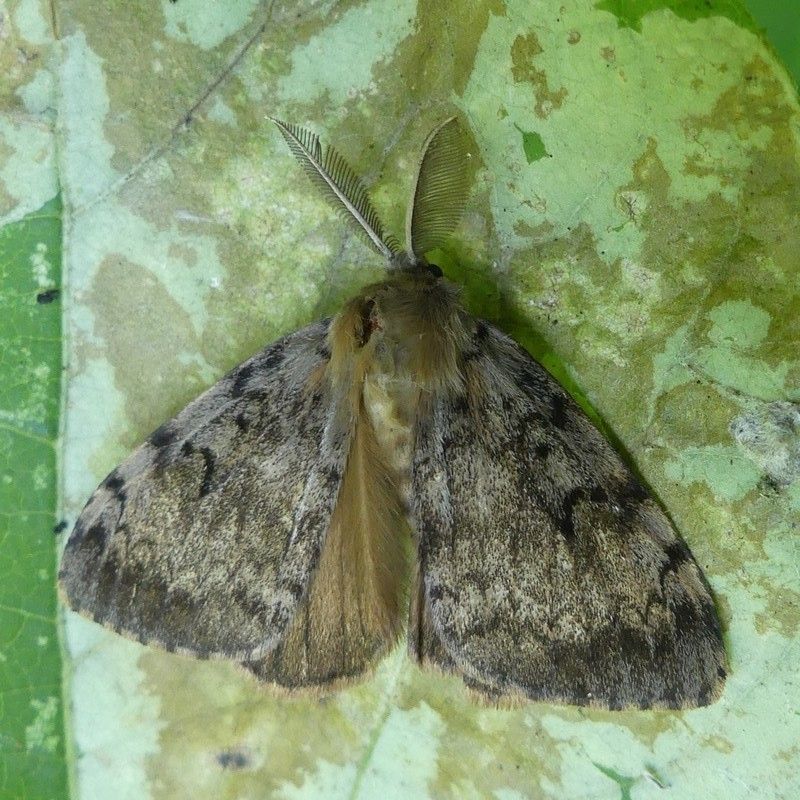reprinted from ParksOntario.ca | Jul 22, 2020
If you’ve seen an Ontario oak tree recently, you’ve likely been introduced to the invasive Gypsy Moth (Lymantria dispar).
Gypsy Moth caterpillars were first introduced to North America in the late 1860s, and are voracious eaters! Their favourite cuisine is oak leaves, but in particularly bad outbreak years — like this one — they can spread to many other tree species.
Leaf me alone, moth!
Having eaten their fill, the caterpillars will pupate in July
Gypsy Moth caterpillars (or larvae) change as they grow. Young caterpillars emerge from egg masses in late May and feed on leaves until early July. Mature caterpillars can be as long as 2.5 inches.
As the caterpillars go through their life cycle, trees can seem to lose their leaves overnight. This often makes campers and visitors concerned about the health of our park trees and ecosystems.
While insecticidal sprays do exist, they have many drawbacks, including the high cost of treating large areas and the possibility of unintentionally killing native moth and butterfly species (including species at risk).
Fortunately, healthy trees are quite resilient to these leaf-munchers.
Although losing their leaves means that trees won’t be able to grow much this year, many will develop a second or even third flush of leaves later in the season.
It takes several years of intensive caterpillar assault to endanger a tree’s life. Historically, severe Gypsy Moth outbreaks have only occurred around every seven to ten years.
How can I help?
This is something our trees have seen before, and they will see it again. But there are many things you can do to help:
Female Gypsy Moth
Do what you can to reduce your carbon footprint. Gypsy Moth outbreaks are associated with warm winters, and cool, wet spring conditions promote the spread of naturally occurring viruses in the population that play a key role in population collapse in outbreak years. Their eggs don’t survive sustained cold temperatures, so global warming may threaten more frequent outbreaks in the future.
Do your best to remove caterpillars, pupae, and moths from your vehicles and equipment before traveling to parks, and again before traveling home.
Female Gypsy Moths can’t fly, so their population cannot quickly move into new areas without being transported there
Don’t move firewood long distances. While Gypsy Moths, Emerald Ash Borer beetles, and other pests may already be living at your destination, there are many others we want to keep out.
Educate yourself and others about threats to our trees and forests. In particular, our now-weakened oak trees are in danger from Oak Wilt, an invasive fungus just across the Canada-US border. Never prune or cut an oak tree between April and July.
An ounce of prevention is worth a pound of cure
Once an invasive species is established in an ecosystem, control efforts can sometimes do more harm than good. In this case, we should learn the lesson that prevention is better than cure, and focus on keeping new invasive species out of Ontario.
While leafless forests may look sad, we expect our natural spaces to soon recover.
More Stories
- No Winner Yet in Catch The Ace But Fundraising Target Met
- South Frontenac Food Bank Opens Second Location in Battersea
- Sharbot Lake Pentecostal Church Anniversary - 1925-2025
- Frontenac Holistic Health Fair - September 20 At Storrington Centre
- Odd Year For Real Estate - But Sales Are Steady Year Over Year
- 193rd Kingston Fall Fair
- Kim Phuc - the Napalm Girl - To Visit Flinton In November
- South Frontenac Council - September 2
- Sticker Shock - EV Charging Station To Cost North Frontenac Township
- 30th Anniversary Verona Car Show

